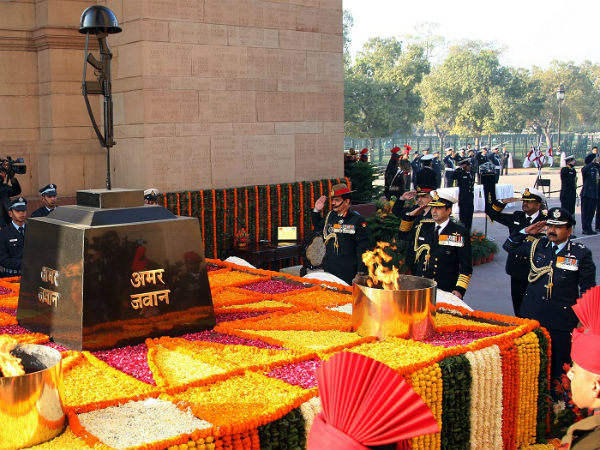India Gate, was originally known as the All India War Memorial. The structure is a war memorial, which is located along Rajpath in New Delhi on the eastern side of the ceremonial axis, which was known as the King's Way.
The structure is a memorial built in memory of the 82,000 soldiers of the Indian Army, who laid down their lives during the First World War (1914-1921). The soldiers laid down their lives in various countries such as France, Mesopotamia, Persia, East Africa and elsewhere in the near and far East.

PC: Arian Zwegers
Although the India Gate is a war memorial, it showcases the architectural style of the triumphal arch like the Arch of Constantine, which is located outside the Colosseum in Rome. The structure is often seen together with the Arc de Triomphe in Paris.
After the Bangladesh Liberation war in the year 1971, a small structure of a black marble tomb, with a reversed rifle which is capped by an army helmet was built beneath the archway of the memorial, this structure was named as Amar Jawan Jyoti, or the Flame of the Immortal Soldier.

Best Time To Visit The Memorial
The months starting from October to March are seen as the best months to visit the capital city, where the memorial is located. A visit during Republic Day, Independence Day, Vijay Divas and Infantry Day also would let one feel proud and patriotic.
History Of The Memorial
The India Gate was a part of the Imperial War Graves Commission, which was formed in the year 1917, and was commissioned to build war graves and memorials for the soldiers who were killed in the First World War.

PC: Edmund Gall
The foundation stone of the Memorial was laid on 10th February, 1921, by the Duke of Connaught and was attended by the Officers and the Men of the Indian Army, Imperial Service Troops and by viceroy Chelmsford.
At the ceremony, the Deccan Horse, 3rd Sappers and Miner, 6th Jat light Infantry, 34th Sikh Pioneers, 39th Garhwal Rifles, 50th Scinde Rifles, 117th Mahrattas and the 5th Gurkha Rifles were honoured by giving the title of Royal in recognition of the services and gallantry of the Indian Army shown during the war time.
The Memorial was inaugurated by the then Viceroy Lord Irwin on February 12th, 1931, and was named as the All India War Memorial.
Design Of The Memorial
The Memorial was designed by Edwin Lutyens, who was also the main architect of New Delhi and was also a leading designer of war memorials during the time. The India Gate, like the Cenotaph in London, is a secular memorial which is free of religious and culturally specific iconography like crosses, etc.

PC: Abhatnagar2
The monument is known as a creative reworking of the Arc de Triomphe, which spans to a height of 30 ft and lies on the eastern axial end of the Rajpath, which is the main ceremonial procession route in New Delhi.
The 42 m tall structure stands on the base constructed out of red Bharatpur stone and rises up in stages to form a huge moulding. The shallow domed bowl at the top was intended to be filled with burning oil on special occasions, which is very rarely done.

PC: Koshy Koshy
The India Gate is a hexagon complex with a diameter measuring about 625 m, which covers approximately 306,000 sq m in area. About 150 m East of the war memorial is a 73 ft cupola, which is inspired by the 6th century pavilion from Mahabalipuram. Under the cupola, there was a 55 ft tall marble statue of King George V, which was later on shifted to Coronation Park.
Amar Jawan Jyoti
Amar Jawan Jyoti translates to 'the flame of the immortal soldier'. It is a black marble plinth, which has a reversed rifle capped by a war helmet and is bound by four urns, each of which has permanent burning lights and is erected under the India Gate in honour of the Jawans who laid down their lives in the 1971 war.

PC: Indian Navy
The structure was inaugurated by the then Prime Minister Indira Gandhi on 26th January, 1972, and since then it has been serving as the India's Tomb of the Unknown Soldier. Each of the four urns has a flame, but only one of the four flames burns throughout the year.
On Independence Day and Republic Day, all the four flames are lit at the same time. The flames are burnt with the help of CNG. The Amar Jawan Jyoti is guarded 24x7 by the soldiers from the Indian Army, the Indian Air Force and the Indian Navy.

PC: Narendra Modi
Every year on the Republic Day, it has become customary for the President, Prime Minister, Chiefs of the Army, Navy and the Air Force along with the dignitaries to place a wreath and pay homages to the unknown soldiers who laid down their lives for the country.



 Click it and Unblock the Notifications
Click it and Unblock the Notifications























